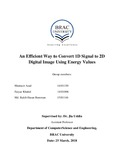| dc.contributor.advisor | Uddin, Jia | |
| dc.contributor.author | Azad, Muntasir | |
| dc.contributor.author | Khaled, Faiyaz | |
| dc.contributor.author | Rumman, Md. Rakib Hasan | |
| dc.date.accessioned | 2018-05-27T02:46:23Z | |
| dc.date.available | 2018-05-27T02:46:23Z | |
| dc.date.copyright | 2018 | |
| dc.date.issued | 2018-04 | |
| dc.identifier.other | ID 14101150 | |
| dc.identifier.other | ID 14101006 | |
| dc.identifier.other | ID 15101144 | |
| dc.identifier.uri | http://hdl.handle.net/10361/10199 | |
| dc.description | This thesis is submitted in partial fulfilment of the requirements for the degree of Bachelor of Science in Computer Science and Engineering, 2018. | en_US |
| dc.description | Cataloged from PDF version of thesis. | |
| dc.description | Includes bibliographical references (pages 28-30). | |
| dc.description.abstract | Image processing and feature extraction techniques are mandatory for any image based application. Basically, major goals of texture research in computer vision are to understand, model and process texture and ultimately to simulate human visual learning process using computer technologies. Our proposal is to create a new efficient approach for converting 1D signal to 2D digital image. Here we will be using 1D signal, which will be converted into 2D digital image using energy values.
In the past, all approaches of the signal processing techniques, the signal is always processed in one dimension (1-D) representation; therefore, a huge relationship information between time and frequency coefficients is easily lost. To eradicate these problems, two dimensions representation of the signal using energy values is evaluated in this thesis.
The main goal of this thesis is to focus on developing an efficient way for converting 1D signals to 2D digital image to get a perfect accuracy than other approaches. It includes some important steps by which we will find our result. Signal acquisition is the first part of our work, then comes the signal reprocessing. After that we extract the feature from the image to justify the different textures and finally the classification part, being done with these steps we are finding out the accuracy with a new efficient approach by which we created the 2D digital image.
In the proposed system, at first it takes 1D fault motor signals and then we are applying Empirical Mode Decomposition algorithm to detect the low frequency which basically represents noise and remove it from the signal. After obtaining the processed signal we have calculated energy values of each signal frame and converted into 2D gray-level images. After that we are using Segmentation-based Fractal Texture Analysis method to extract the feature vectors. Then we have classified our gray level images using support vector machine which has high classification ability.
Finally the performance of this proposed approach is compared to other techniques of feature extraction methods by providing the accuracy and thus our proposed approach is one of the efficient techniques for feature extraction methods . | en_US |
| dc.description.statementofresponsibility | Muntasir Azad | |
| dc.description.statementofresponsibility | Faiyaz Khaled | |
| dc.description.statementofresponsibility | Md. Rakib Hasan Rumman | |
| dc.format.extent | 30 pages | |
| dc.language.iso | en | en_US |
| dc.publisher | BRAC University | en_US |
| dc.rights | BRAC University theses are protected by copyright. They may be viewed from this source for any purpose, but reproduction or distribution in any format is prohibited without written permission. | |
| dc.subject | Image processing | en_US |
| dc.subject | | en_US |
| dc.subject | | en_US |
| dc.subject | Digital image | en_US |
| dc.subject | Computer vision | en_US |
| dc.title | An efficient way to convert 1D signal to 2D digital image using energy values | en_US |
| dc.type | Thesis | en_US |
| dc.contributor.department | Department of Computer Science and Engineering, BRAC University | |
| dc.description.degree | B. Computer Science and Engineering
| |

